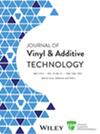Synthesis, mechanical, thermal, and fire properties of poly(vinyl chloride) modified with a new flame retardant based on zeolite and urea cyanurate
Abstract
In the article, polyvinyl chloride/zeolite 4A/urea cyanurate composites (P/UCA-Zlt) were designed and prepared by a melt intercalation method suitable for the manufacture of rigid products. To determine the structure and properties of this flame-retardant system, thermal, flame retardancy, and mechanical behavior were tested by Fourier transform infrared analysis (FTIR) spectroscopy, field emission scanning electron microscopy (FE-SEM), thermogravimetric analysis (TGA/DTG), thermal stability test, cone calorimetric test (CCT), and tensile analysis. Results showed that the composites, based on UCA-Zlt, exhibited better flame retardancy, better HCl scavenger properties, improved mechanical properties, and reduced level of degradation compared with the pure polyvinyl chloride (PVC) at the optimum modification UCA (3 wt%)–Zlt (1%). TGA, indicated that the stability against heat influences of PVC was increased by adding UCA–Zlt which was evident by the increased thermal decomposition temperature. The CCT results of the PVC composites increased flame-retardant properties. The PVC matrix composites improved the thermal stability time of PVC as the optimum value of 1 wt%. Moreover, the tensile strength of the composite containing UCA (3 wt%)–Zlt (1%) increased by 19.8% compared with those of neat PVC.
Highlights
- A strategy to design an FR-additive from zeolite and urea cyanurate for PVC.
- Introduce a guide suitable for the thermal stability of PVC formulation.
- Effects of zeolite on thermal stability and flame retardancy of PVC.
- Introducing an optimal FR-PVC system with improved mechanical properties.




 求助内容:
求助内容: 应助结果提醒方式:
应助结果提醒方式:


